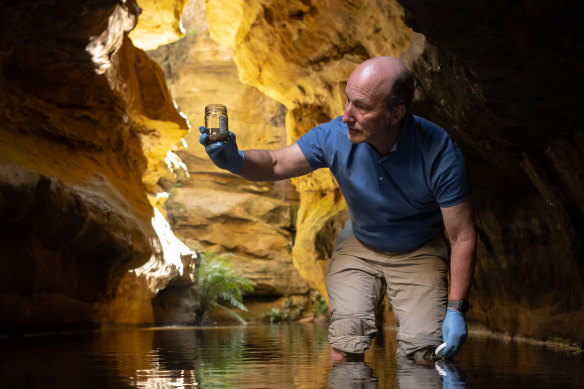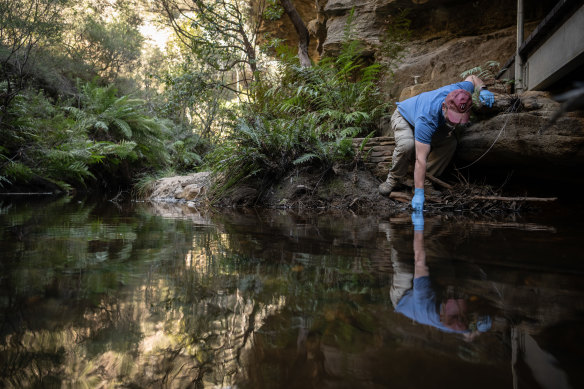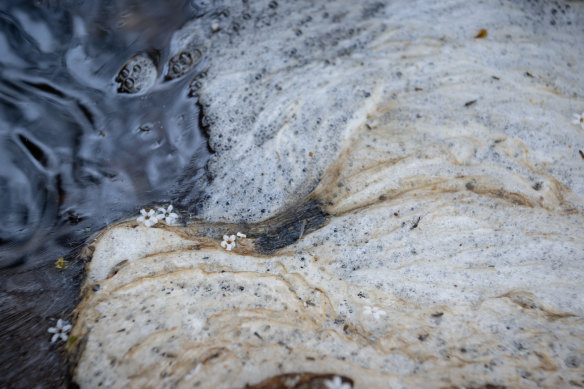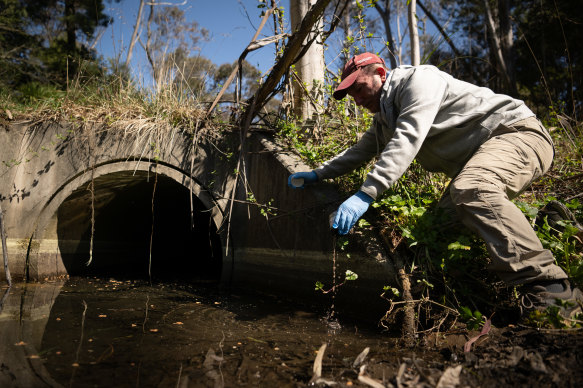By Ben Cubby and Carrie Fellner
Synthetic PFAS chemicals flowing into a Blue Mountains dam in the Sydney drinking water catchment have been detected at levels more than 50 times higher than Australian drinking water standards – far higher than authorities have previously admitted.
Independent tests commissioned by the Herald also show the plume of “forever chemicals” has already passed beyond Medlow Dam, near the town of Medlow Bath, and flowed into the World Heritage Area at concentrations among the highest yet recorded in Australian waterways.

Water scientist Ian Wright takes a sample of PFAS-contaminated water in a sandstone canyon at Greaves Creek, below Medlow Dam.Credit: Wolter Peeters
Water NSW announced that it had shut off a pipeline connecting Medlow Dam and nearby Greaves Creek Dam from drinking water supplies as a precaution on August 28, following government tests that showed PFAS present in the water at 0.09 micrograms per litre – slightly above the Australian guidelines of 0.07 micrograms.
But the new tests conducted in early September show PFAS concentrations at 3.7 micrograms per litre, more than 50 times higher than the guidelines, in Adams Creek which feeds the dam.
In Greaves Creek, below Medlow Dam, foamy water was found to contain more than 14 micrograms per litre – around 200 times drinking water guidelines and among the highest levels of PFAS recorded in Australian water.
“The results are white-hot,” said Western Sydney University water scientist Ian Wright, who gathered samples for independent testing.
“We have gone in a couple of months from ‘there are no hot spots in the catchment area’ to these very disturbing results. The only difference is that now we’ve started testing.”
The situation has escalated since a Herald investigation revealed in June that no large-scale testing for PFAS in the state’s drinking water was taking place. The official position was that routine monitoring of tap water was unnecessary because there were “no known PFAS hotspots in the catchment”.
After initially dismissing the Herald’s reporting, authorities quietly commissioned tests which showed elevated levels of PFAS in Medlow Dam. In response to those tests, Water NSW shut the pipeline linking Medlow Dam and neighbouring Greaves Creek Dam off from the system that supplies 49,500 people with drinking water in the Blue Mountains.
In response to questions sent by the Herald this week, Water NSW said drinking water supplies were “safe and secure” because the pipe connecting the PFAS-contaminated dams to the wider drinking water system had been closed.

Wright taking samples in Greaves Creek.Credit: Wolter Peeters
“A key focus of the investigation is to determine the source of PFAS contamination within the Blue Mountains catchments,” a spokesperson said. “Water NSW continues to maintain heightened vigilance across all dams in the Blue Mountains region.
“The investigation includes extensive testing, at multiple sites, and incorporates a review of land use activities where historical use of PFAS may have occurred.”
The agency did not respond to questions about whether its own tests had shown similar levels to the Herald-commissioned tests. It did not say how long the dam would be shut or how long PFAS-contaminated water had been flowing into the drinking water system before the pipeline was closed on August 28.
PFAS – per- and polyfluoroalkyl chemicals – are synthetic chemicals which persist for long periods in the natural environment. Some have been linked to causing cancer by the World Health Organisation.
The government is now scrambling to find the source of the Medlow Dam contamination.
The Herald understands that one line of inquiry concerns firefighting foam being used to douse car crash sites on the stretch of the Great Western Highway near Medlow Bath and Blackheath.
Foam containing PFAS was phased out in 2007, but investigators believe foam residues may have accumulated in the water table under the town over a period of decades.
Fire and Rescue NSW has been trawling through old records to try to determine the type and quantity of firefighting foam used to douse a blaze after a Shell petrol tanker crashed and burned in 1992, at a point in the road close to the section of Adams Creek where high levels of forever chemicals were found.

Foam gathering in PFAS-contaminated water downstream of Medlow Dam.Credit: Wolter Peeters
Another line of inquiry points to the Medlow Bath Rural Fire Service Station as a possible source.
The RFS building, which sits about 200 metres away from Adams Creek, had firefighting foam containing PFAS stored in it in the past.
But the RFS said no large-scale training had taken place there. The firefighting service said it was investigating further.
“Class A” foams, which are used to fight bushfires, do not contain PFAS.
The tests commissioned by the Herald found high levels of PFAS in Adams Creek close to the northern section of Medlow Bath township, but none in other creeks that feed Medlow Dam.
Wright could not test in the dam itself, which is in the restricted catchment area, but samples were taken below Medlow Dam in Greaves Creek.
In the sandstone canyons below the dam, at the Walls Cave Indigenous heritage site, scuds of foam could be seen building up on snags in the river.
One water sample that contained some foam showed 14.04 micrograms of PFAS chemicals per litre – 200 times Australian drinking water levels. Another sample taken nearby was 0.08 micrograms, or only slightly above safe drinking water levels. This suggested PFAS was accumulating in the foam, Wright said.

Some samples near Medlow Bath detected no PFAS, suggesting the source was close to the northern section of the township.Credit: Wolter Peeters
Sediment samples taken above and below the dam also showed significant PFAS levels. Wright said that more detailed studies were needed to understand how PFAS was moving through the river system, but it seemed likely that rainfall was continuously flushing out forever chemicals caught in sediment and sending them downstream.
“I think this [PFAS] is sitting there in the water table – that’s what the results suggest to me,” Wright said. “But these samples give us a window into the water table. You’d need to do a lot more study, but it’s not clear how they can fix this. That’s a real concern.
“The PFAS is just sitting in the aquifer and the sediment, and reactivating when there is rainfall,” he said. “This has potentially been going on for a long time. Fixing it looks like being a very expensive process.”
The samples were collected by Wright, an experienced water scientist, to strict quality control standards, and the tests were performed by Envirolab, an independent laboratory that does commercial and government work.
Professor Stuart Khan, a water expert and Head of School of Civil Engineering at the University of Sydney, has previously said it wasn’t necessary to shut the dam, but after seeing the tests results he agreed it should be shut.
“These sorts of concentrations are unacceptable and so we shouldn’t be using that water,” said Khan, who was not involved in the testing process. “If shutting it off helps maintain lower concentrations of PFAS at the Cascade filtration plant, that’s a good thing.”
However, he stressed that by the time the water had been piped to the Cascade Dam, diluted with other water not affected by PFAS and processed through a filtration plant, it was safe to drink.
“What matters is what’s coming out of customers’ taps,” he said.
Khan said he thought the situation could be managed by ongoing monitoring.
US corporate giant 3M made billions from producing PFAS chemicals, which are useful for resisting heat, stains, grease and water. It has been accused of covering up the health risks associated with the products since the 1960s.
A federal parliamentary inquiry into the health effects of PFAS was announced in August.
Australian drinking water guidelines are also currently under review.
Get to the heart of what’s happening with climate change and the environment. Sign up for our fortnightly Environment newsletter.